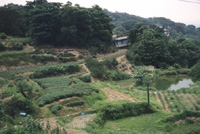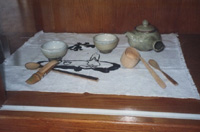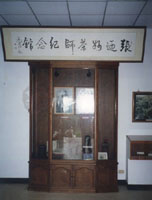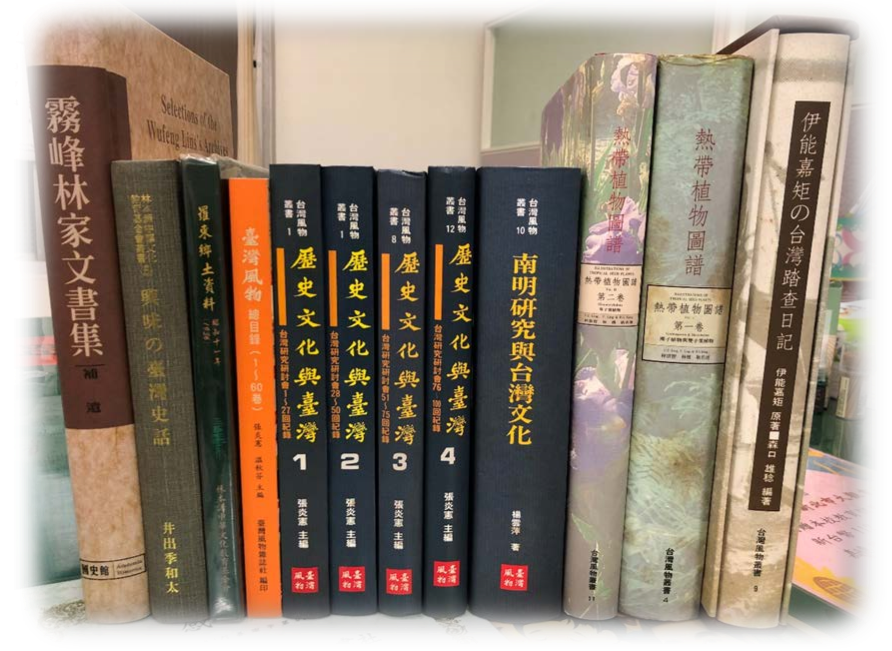 木柵茶史
木柵茶史
The history of Mucha and tea
溫振華/Wen Chen-hua
(師大歷史系教授)
(Professor, History Department, National Taiwan Normal University)
2001-07-09
 Tea park landscape
Tea park landscape
以鐵觀音茶聞名的木柵茶園是全國第一處觀光茶園,早在一七七○年代,來自中國茶鄉福建安溪的移民即攜帶茶種陸續來此開墾。木柵以其丘陵地形與良好的排水等在先天條件上為種茶的福地,卻因地處偏遠與茶農不諳市場運作,茶葉貿易歷經了幾代的興衰。直到一九八○年十二月,當時的台北市長李登輝成立觀光茶園,才使沒落的茶業再現生機。本週「台灣歷史之窗」特別邀請師大歷史系教授溫振華執筆,細數木柵茶史兩百年來的興衰榮枯,並針對今日木柵觀光茶園經營的狀況與方向做一說明。
Famous for its “tie kuanyin” variety of oolong tea, the Mucha Tea Park is Taiwan’s first sightseeing tea park. Back in the 1770s, Chinese immigrants from tea-growing villages in Anxi, Fujian Province, brought tea plants to Taiwan and began to develop the land. Mucha, with its hilly topography and favorable drainage had all the right conditions to be a good tea-growing area, but because the region was fairly remote and the tea farmers were not familiar with the workings of the market, the trade in tea leaves saw many ebbs and flows over the generations. Fast forward to December 1980, when Taipei City Mayor Lee Teng-hui set up the Sightseeing Tea Park, and the tea trade, by then in decline, was given a new lease of life. This week, Window on Taiwan is written by Wen Chen-hua, a professor from National Taiwan Normal University’s History Department, who gives a detailed history of the rise and fall of Mucha tea during the last two hundred years, and tells us about business today in the Mucha Sightseeing Tea Park.
木柵,尤其是貓空,是台北夜貓族的好去處。雖然木柵一帶種茶的歷史頗久,但成為夜間飲茶的去處只不過是二十年的光景。木柵多丘陵,是茶樹生長的好環境。隨著時代的變化,木柵地方茶葉的生產歷經四個階段的發展:
Mucha, particularly Maokung, is a popular hangout for Taipei’s “night cats.” Although tea growing around the Mucha area has had a fairly long history, it’s only been a place to go and drink tea by night for the last twenty years. Mucha is very hilly, providing a good environment for tea bushes to mature. There have been four main stages in the history of tea production at Mucha.
漢移民開始植茶
木柵山丘一帶在漢人進入之前屬於凱達格蘭族雷朗社的土地。一七七○年代左右,漢人陸續從中國原鄉福建省安溪縣來此開墾。安溪縣是中國的茶鄉,因此安溪移民來台時,有的人也攜帶茶種。張美加先生說,他的祖先在安溪鄉時就種茶,來台時攜帶茶種,先在士林一帶墾殖茶種,並未成功,後來發現木柵適合種茶,因此就從士林移居木柵。這種類似的移民的經驗在木柵一帶常可聽老人談起。
Han Chinese immigrants begin to plant tea
Before the arrival of the Chinese, the hills of Mucha belonged to the Luilang Ketagalan tribe. Around the 1770s, Han Chinese started to arrive from their hometowns in Anxi County, Fujian Province, China, and began to develop the land. Anxi County is a tea-growing region of China, and so when immigrants from Anxi arrived in Taiwan, some of them brought tea plants with them. Mr. Chang Mei-chia says that his ancestors grew tea in Anxi, and came to Taiwan carrying tea plants. They first developed tea cultivation in the Shihlin area, but having no success, they then discovered that Mucha was suitable for tea growing, and so they moved there. It’s possible to hear many tales of similar experience among immigrants from old people in the Mucha area.
雖然木柵適合茶樹的種值,但茶葉的製造與貿易涉及諸多的問題,如生產的技術或是銷售的管道,以及價格的高低,都使得早期茶葉的生產受到限制,因此沒有多大發展。反而,因當時藍染的利潤較高,山丘遍植大菁,製造藍色染料。
Although Mucha was suitable for growing tea bushes, tea production and the tea trade ran into many problems. For instance, production techniques, or marketing channels, and price fluctuation all hindered tea production in the early days, and so there wasn’t a great deal of development. On the contrary, because there were more profits to be made from indigo, the hills were planted with indigo plants for the production of indigo dye.
 Tea set in the Chang Nai-miao Tea House
Tea set in the Chang Nai-miao Tea House
洋行主導時期
一八六○年,由於清帝國對外戰爭失敗,台灣的淡水口開放為對外通商口岸,經濟活動亦隨之被納入世界的經濟體系之中,洋人紛紛來台尋找貿易機會。當時,英國駐淡水的領事郇和曾把木柵一帶的茶葉寄回本國檢驗,不過得到的答案是茶葉製造不良。後來,促成台灣茶葉發展的是英國商人陶德,他曾在文山區一帶考察茶樹的栽培及其發展的可能性。
The age of the Western tea companies
In 1860, because of the Qing court’s defeat in the second Opium War, the mouth of the Tamshui River in Taiwan was opened up as a commercial port for foreign trade, and as economic activity ensued, Taiwan was brought into the global economic system. Westerners poured into Taiwan looking for trading opportunities. At that time, the British consul stationed at Tamshui, Robert Swinhoe, sent some Mucha tea back to Britain to be tested. He received the reply that the tea production process was poor. Later on, a British merchant by the name of John Dodd promoted the development of tea production in Taiwan. He investigated the cultivation of tea bushes in the Wenshan District and the possibility of development.
當時世界市場極需茶葉,而中國的廈門、福建、漢口茶葉的輸出卻處於衰退時期。陶德抓住這個機會於一八六六年自中國福建安溪引入茶樹,在木柵附近種植,並全數收購,激勵農民種茶的信心。為改善茶葉製造品質,陶德更投資新的製茶設備。一八六九年,名茶由淡水出口,運銷美國,頗受歡迎。洋商見茶葉貿易頗有利潤,紛紛來台投資。較有名的有寶順洋行、德記洋行、怡記洋行、永隆洋行以及和記洋行。
Tea was greatly in demand in the world market at that time, and exports of tea from Xiamen, Fujiian and Hankou in China were on the wane. Dodd grasped this opportunity, and in 1866 he imported tea plants, planted them around Mucha, and he bought all the harvested tea, giving farmers the confidence to grow tea. In order to improve the quality of tea production, Dodd invested in new tea production equipment. In 1869, brand-name tea was exported out of Tamshui, and transported for sale in America, where it became popular. Western merchants saw the tea trade as very profitable, and many of them came to Taiwan to invest in it. The better known companies were Dodd & Co., Tait & Co., Ellas & Co., Brown & Co. and Boyd & Co.
茶葉的生產,可分為粗製與精製兩種過程。粗製是在產地進行的,也僅在地方販賣。精製的地點先是在艋舺,後因當地人反對,一八七○年左右遂遷至大稻埕。洋行與茶葉精製集中大稻埕是大稻埕港市興起的主要背景。
There were two different processes for producing tea: coarse processing and fine processing. Coarse processing was carried out near to where the tea was grown, and such tea was only sold locally. Fine processing first took place in Wanhua, but because local people objected, in around 1870 it was moved to Ta Tao Cheng [around the Tihua Street area]. The Western companies and fine processing of tea leaves concentrated around Ta Tao Cheng were the main reasons behind the flourishing of this area as a harbor city.
由於茶葉利潤高以及洋行貸款給茶農,茶樹的種植區跟著急速擴張。一八七七年,有位洋人在大稻埕這樣描述:放眼望去,盆地周圍山丘火光熊熊,農民正在清除雜木,準備種植茶樹。在這個大環境下,木柵山區原有的大菁被剷除,紛紛改種茶樹。沒有開墾的荒地,也整地種茶。這是木柵種茶的黃金時代。
Because of the profits to be made from tea, and the loans which Western companies gave to the tea growers, the area planted with tea bushes expanded rapidly. In 1877, a Westerner gave a description of Ta Tao Cheng as follows: “I look around and see fires blazing on the hills that surround the basin. The farmers are currently clearing the trees and foliage away, preparing the land for tea planting.” In this way, the Mucha hills had their indigo plants removed, and the land was given over to tea bushes. The land which had not been developed was also planted all over with tea bushes. This was the golden age for tea production in Mucha.
因為出口的茶必須經過精製的過程。因此木柵本地的粗製茶或由景美溪、新香溪用船運至大稻埕,或由木柵挑至大稻埕再製。木柵與大稻埕間有著緊密的連結。
Because tea for export had to undergo fine processing, coarsely processed tea was transported from Mucha to Ta Tao Cheng either by boat, on the Chingmei and Hsinhsiang Creeks, or by foot, for further processing. Close links were established between Mucha and Ta Tao Cheng.
日本時代鐵觀音的引入
日本統治台灣後,洋行控制下的茶葉生產,透過株式會社貸款茶農驅逐洋行資本。其次找尋新茶種,講求新製茶技術,增加茶葉的品質與產量。
The introduction of Tie Kuanyin tea during the Japanese occupation
After the Japanese took control of Taiwan, tea production, which had been controlled by Western companies, was now aided by Japanese company loans to the tea farmers, and Western capital was driven out. The Japanese then began to search for new varieties of tea, refined tea production techniques, and raised both quality and quantity of tea output.
一九一九年木柵第一家茶葉公司--木柵茶葉公司成立,七年後又有規模更大的「文山茶葉株式會社」出現。這是木柵本身自製優良茶的開始。此時,在日本殖民政府的鼓勵下,茶葉生產邁入機械化時代。
In 1919, Mucha’s first tea company, the Mucha Tea Company, was set up. Seven years later came the even larger Wenshan Tea Co., Ltd. This was the beginning of superior tea production in Mucha itself. At this time, with the encouragement of the Japanese colonial government, tea production entered the machine age.
 Chang Nai-miao Memorial Hall
Chang Nai-miao Memorial Hall
不過,被視為木柵茶葉特色的是木柵鐵觀音。鐵觀音茶是日本時代木柵鄉民張迺妙、張迺乾二人從祖先原鄉福建安溪引進的。他們在喝了鐵觀音茶後,發現茶葉沖泡四、五次味道依然香醇甘美,於是索取十二叢帶回木柵。那時日本殖民政府為鼓勵優良茶葉的製造,舉行茶葉競賽。張迺妙種植的鐵觀音曾參加日本總督府舉辦的「茶葉共進會」比賽,獲得頭獎。今天這個獎牌,陳列在貓空附近其後裔設立的「張迺妙紀念館」,供人追憶。張迺妙在鐵觀音獲獎後,在地方人士的建議下再度前往安溪,攜回一百叢茶種,分送木柵茶農每人10至20叢,最初成果不佳。一九二六年「文山茶葉株式會社」成立後,在今木柵國小後山附近栽種,才開始漸入佳境。張迺妙也因為經驗豐富,被官方聘為茶葉製造指導教師,從事製茶品質的改進。到木柵貓空飲茶,別忘了順道參觀「張迺妙紀念館」,重溫木柵茶葉發展重要的一頁。
However, Mucha tie kuanyin (literally, “iron goddess of mercy”) tea is seen as the quintessential Mucha tea. Tie kuanyin tea was introduced during the Japanese era by two Mucha locals, Chang Nai-miao and Chang Nai-chien, who brought it from their ancestral home in Anxi, Fujian. After drinking this tea, they discovered that the leaves could be brewed four or five times and still keep their mellow and refreshing flavor. They then asked for 12 tea bushes to take back to Mucha. At that period, the Japanese colonial government held tea competitions to encourage superior tea. The tie kuanyin tea grown by Chang Nai-miao was entered in one of these competitions, and won first prize. This medal is on display today at the Chang Nai-miao Memorial Hall that was set up by his descendants near to Maokung, to preserve his memory. After winning this prize for his tie kuanyin tea, Chang Nai-miao went back again to Anxi at the suggestion of local people, and brought back 100 tea plants, which he distributed to several Mucha tea farmers in batches of 10 or 20. The initial results weren’t good. It wasn’t until 1926, when the Wenshan Tea Co., Ltd. was established and began cultivation now on the hills behind the site of today’s Mucha Elementary School that results slowly began to improve. Because of his rich experience, Chang Nai-miao was employed by the government as a tea production advisor and expert, and devoted himself to the improvement of tea quality. When you go to drink tea at Maokung, Mucha, don’t forget to stop by the Chang Nai-miao Memorial Hall, and brush up on this important page in the development of Mucha tea.
觀光茶園的興起
日本經台後期,因為第二次大戰,木柵的茶葉生產深受影響,戰後衰退的景象沒有改善。一直到李登輝擔任台北市長時,鑑於農家宅舍因法令無法整建,特准翻修,並輔導茶農改善居宅環境。一九八○年十二月成立茶園,成立之初計有53戶參加,木柵的茶葉文化再現生機。為了推銷觀光茶園的茶葉,每年舉行春、秋、冬優良鐵觀音比賽。評分的標準是:香氣與味道佔50%,外觀形狀佔30%,葉色佔20%。隨著都會生活緊張,木柵觀光茶園把茶農自製自銷的茶葉與飲茶休閒生活結合在一起,成為台北市郊特殊的飲茶休閒文化。到貓空喝杯茶,除了領受茶品本身的甘醇濃冽,若能瞭解當地的茶史,將會添增一份歷史感。
The rise of the sightseeing tea park
During the later period of Japanese occupation, the Second World War had a deep impact on tea production in Mucha, and after the war ended, the industry’s depressed fortunes fared no better. Fast forward to Lee Teng-hui’s office as Taipei City Mayor, when, because laws prohibited farmers from making repairs to or rebuilding their farmhouses, he gave permission for them to make extensive renovations, even rebuild, and advised the tea farmers on how to improve their living environment. In February 1980, he established the tea park. To begin with, 53 farms participated, and Mucha’s tea culture was given a new lease of life. In order to promote the tea in the sightseeing park, competitions were held each spring, autumn and winter for the best tie kuanyin tea. The criteria for grading are as follows: aroma and flavor count for 50%, appearance, 30%, leaf color, 20%. As city life becomes increasingly stressful, the Mucha sightseeing park brings together the tea produced and sold by the tea farmers themselves, and the leisure activity that is drinking tea, and it’s become a special part of the Taipei’s suburban eating and drinking culture. Understanding the history of the area will enhance your next cup of tea when you go to Maokung, and you can enjoy not just the rich, flavorful tea, but a little sense of history, too.
Edited by Tina Lee/ translated by Elizabeth Hoile
李美儀編輯/何麗薩翻譯









